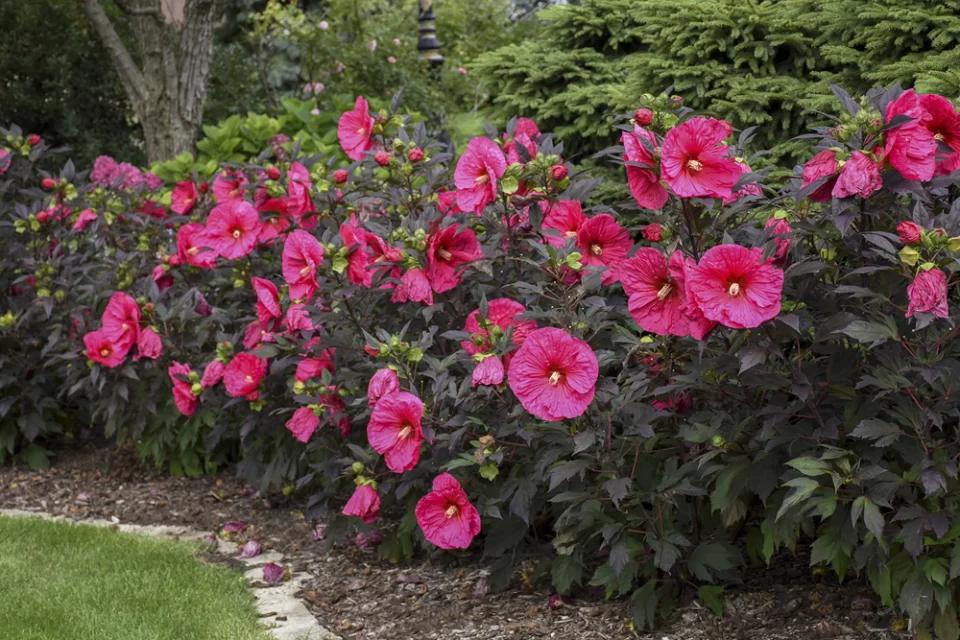Hibiscus plants are attractive flowering shrubs that can add a vibrant splash of color to your garden. However, in order to experience the beautiful blooms and lush foliage of hibiscus plants, regular maintenance is necessary. Here is a step-by-step guide on how to keep your hibiscus blooming.

- Fertilize Routinely: Fertilizing is a must in order to have a healthy, blooming plant. Use a good-quality, balanced fertilizer every two to four weeks and make sure to follow the directions on the packaging. Avoid over-fertilizing, which can cause the plant’s leaves to yellow and drop.
- Water Consistently: Hibiscus plants need a consistent supply of water to thrive. The plants should be watered when the top 1-2 inches of soil feels dry to the touch. Hibiscus plants require a lot of water, and the soil should always be kept consistently moist. However, it is important to avoid over-watering, as this can lead to root rot. A good rule of thumb is to water your hibiscus when the top inch of soil is dry.
- Provide Adequate Light: Hibiscus plants need plenty of sunlight in order to bloom. Place the plant outdoors in late April in a location that receives full sun all day or at least for six hours. More sun will produce more flowers. As the summer months approach, you may need to move the plant to a shadier area to protect it from the scorching heat.
- Maintain Proper Temperatures: Hibiscus plants are tropical plants and require warm temperatures to thrive. They should be kept in a location where the temperature stays between 60 and 90 degrees Fahrenheit. Avoid placing your hibiscus near air conditioning or heating vents, as these can cause fluctuations in temperature that can damage the plant.
- Deadhead Regularly: Deadheading is the process of removing spent flowers from your hibiscus plant. This is important, as it encourages the plant to produce more flowers. To deadhead, simply pinch or snip off the spent flowers at the base of the stem.
- Prune Regularly: Pruning is another important step in keeping your hibiscus blooming. Pruning encourages the plant to produce new growth, which in turn produces more flowers. To prune your hibiscus, simply cut back any long, leggy branches to encourage bushier growth.
- Check Routinely for Pests and Diseases – Treat as Necessary: Pests and diseases can affect the health of your hibiscus plant, so it is important to check the plant regularly for signs of infestation. Common pests include aphids, mealybugs, mites, and whiteflies. Watch out for telltale signs such as yellow leaves and distorted growth. You can treat the plant with insecticides or natural remedies such as neem oil.
Why is my hibiscus plant not flowering?
A hibiscus plant may not flower due to insufficient light, incorrect temperature, lack of nutrients, pruning at the wrong time, or disease/pest issues. Proper care, including adequate light, proper temperature, fertilizer, and pest control, is needed to ensure blooming.
How to stop hibiscus plant from dropping buds?
There are several steps you can take to prevent your hibiscus from dropping buds:
- Provide proper care: Ensure the plant is getting adequate light, water, and fertilization.
- Maintain consistent temperatures: Keep the plant in an area with temperatures between 60-90°F (15-32°C) to prevent bud drop.
- Avoid over-watering: Make sure soil is moist but not waterlogged, as over-watering can cause bud drop.
- Pest control: Treat any pest infestations as soon as they are noticed to prevent bud drop caused by pests.
- Pruning: Prune the plant after it finishes blooming to keep it healthy and promote new buds.
- Keep an eye on the humidity level: Hibiscus plants prefer humidity levels between 50-70%. Keep an eye on the humidity level and adjust it as needed.
FAQs:
Q: How often should I water my hibiscus plant?
Water your hibiscus plant regularly, keeping the soil moist but not waterlogged.
Q: How much sunlight does a hibiscus plant need?
A: Hibiscus plants prefer bright, indirect sunlight.
Q: What is the ideal temperature range for hibiscus plants to bloom?
A: Hibiscus plants prefer temperatures between 60-90°F (15-32°C) to bloom.
